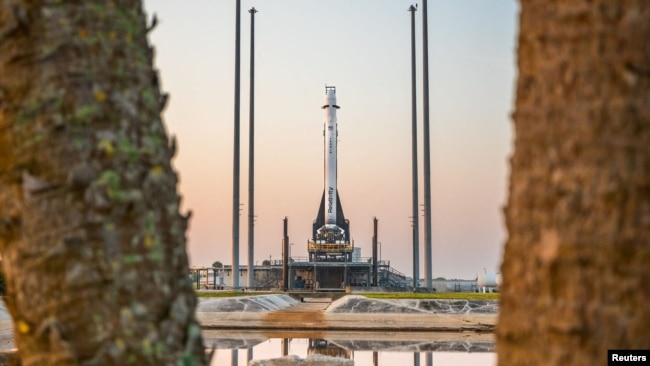上記をクリックして、まずTRelativity Spaceのホームページをご覧ください。2015年、ティム・エリス氏とジョーダン・ヌーン氏が共同で設立した会社。
ティム・エリス氏は、Amazon創業者ジェフ・ベゾス氏が設立したロケットメーカー「ブルー・オリジン」出身。
ジョーダン・ヌーン氏は、イーロン・マスク氏が設立したロケットメーカー「スペースX」にも在籍。
ずばり、開発にかかる人件費を削減でき製造期間も大幅に短縮できるからだそうです。
全長約30メートルの大きさのロケットを製造するのに必要な時間は、わずか30日だそうです。さらに、ロケット製造後のアセンブリやテストにかかる時間も30日程度で、ゼロベースの段階から実際のロケット打ち上げまで、60日あれば十分だそうです。
同社のそもそもの会社設立理由は、「火星でモノづくりをすること」。同社によると、同社が現在行っている大型メタル3Dプリンターでロケットを作るプロセスそのものが火星へ移植可能だそうです。
参照:
https://www.relativityspace.com/
https://j-seeds.jp/column/post-540
VOAで英語を学び、世界の今を堪能しましょう!!
3Dプリンターで作ったロケットがフロリダでの打ち上げ後数分で失敗(和訳)
3D-printed Rocket Fails Minutes after Florida Launch
2023 March 24
ほとんど3Dプリントされた部品で作られたロケットが、水曜日遅くに初飛行を開始しましたが、軌道に到達することはできませんでした。Terran 1と呼ばれる全長33mのロケットは、フロリダ州ケープカナベラルから離陸しました。
スタートアップ企業のRelativity Space社は、3Dプリント技術を使ってロケットの85%を作成しました。ほとんどの部品は、カリフォルニア州ロングビーチにある同社の大型印刷センターで作られました。
Terran 1は無事に離陸し、3分間空中に留まりました。ロケットの第2段、下段、は予定通り打ち上げられ、分離しました。しかし、上段は点火したかと思うと、その後停止し、大西洋に墜落してしまいました。
Relativity Space社は、このロケットが地球の大気圏を通過して燃え尽きるまで、数日間軌道上にとどまることを期待していました。
今月Relativity Space社による2回目の打ち上げ失敗でした。同社は12日前にも、離陸の数秒前に打ち上げを中止していました。
ロケットは軌道に乗りませんでしたが、同社は今回の打ち上げに満足だったと言っています。
アルワ・ティザニ・ケリーさんはRelativity Spaceに勤務しています、そして今回の打ち上げについて話しました。ケリーは、"(最初の)打ち上げはいつもエキサイティングで、今日のフライトも例外ではない"と言っています。
他の宇宙事業者は3Dプリント素材を使用していますが、その作品はロケットのごく一部を占めるに過ぎません。
Relativity Spaceは、2人の若いエンジニアによって2015年に設立されました。同社は、さらに多くの3Dプリント素材を使用したロケットの大型版の開発に取り組んでいると言っています。
The
3D-printed Rocket Fails Minutes after Florida Launch
A rocket made almost entirely of 3D-printed parts started its first flight late Wednesday but failed to reach orbit. The 33-meter-long rocket, called Terran 1, took off from Cape Canaveral, Florida.
The startup company Relativity Space created 85 percent of the rocket using 3D printing technology. Most parts came from the company’s large printing center in Long Beach, California.
Terran 1 took off successfully and stayed in the air for three minutes. The first stage, or lower part, of the rocket launched and separated as planned. The upper stage, however, appeared to ignite and then shut down, sending it crashing into the Atlantic Ocean.
Relativity Space had hoped for the rocket to stay in orbit for several days before falling through Earth’s atmosphere and burning up.
It was the second failed launch by Relativity Space this month. The company called off an attempt 12 days ago just seconds before takeoff.
Though the rocket did not reach orbit, the company said it was pleased with the launch.
Arwa Tizani Kelly works for Relativity Space and discussed the launch. Kelly said that “(first) launches are always exciting and today’s flight was no exception.”
Although other space businesses use 3D-printed materials, the pieces make up only a small part of their rockets.
Relativity Space was founded in 2015 by two young engineers. The company said it is working to develop larger versions of the rocket that will have even more 3D-printed material.
Words in This Story
3-D printing –n. the process of creating an object layer by layer, using a design made on a computer
ignite –v. to cause something to burn
